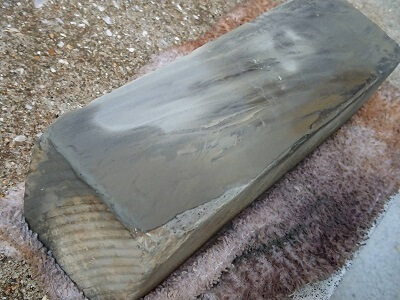Basics of Waterstones
Waterstones are “must have” item for your knife.
Sharpening by waterstones is the only way to maintain cutting performance of Japanese knives.
Geographically, Japanese people could have mined waterstones. Active volcanos and crustal movements enabled to produce good quality of natural stones.
Waterstones have significant roles to develop cutlery culture of Japan represented by Samurai swords. Waterstone districts also became cutlery producing center.
In addition, craftsmen in those areas have developed sharpening method with waterstones produced there. By using same waterstones in a same way, you can also keep excellent cutting performance of your knives!

Types of Waterstones
| Type | Grit * | Purposes |
| Rough Stones | 100 – 600 | Chip in a blade / Grind much |
| Medium Stones | 800 – 1000 | Common uses |
| Finishing Stones | 1500 – 3000 | Prolonging sharpening effect |
* Grits are abrasive grains of waterstones. The size of grits indicates the number of 1 inch divided by grit number of the stone. For example, 1000 Grit waterstone consists of abrasive grains of 0.0254mm diameter (result of 25.4mm divided by 1000, 1 inch equals to 25.4mm).
The smaller number of grit is, the higher sharpening ability of the waterstone becomes. Using waterstones of smaller grit result in rough surface of the edge sharpened with them.
Purpose of Each Stone Type
- Rough stones are suitable to grind much for fixing chip in a blade or for sharpening dull knives. Rough stones are suitable to grind stainless steel knives.
These stones grind edge easily, but they make edge surface rough. So, you need to use medium grit waterstones after rough stones.
- Medium stones make rough edges smooth, so they should be used after sharpening with rough grit waterstones. In case you sharpen knives frequently, starting from medium grit waterstones may be enough.
- In addition, sharpening with finishing stones prevents blade from being rusty to some extent.If you want to keep cutting performance for longer time, you should use finishing stones after sharpening with medium stones. Finishing stones make cutting edge very smooth and sharp, therefore cutting performance lasts long.
In addition, sharpening with finishing stones prevents blade from being rusty to some extent.
Thus, there are wide range of grits for waterstones.
In addition, there are several variations for grits (abrasive grains). Waterstones including GC grits are harder than normal waterstones made of WA grits, therefore possess higher sharpening ability. In case of sharpening solid special-steel knives, these Waterstones are used. Please note that those waterstones with special grits are higher in price.
Please see “choose the best waterstone” page to choose the best waterstone(s) for you, considering materials of your knives, requirements and expectations after sharpening.
Related Pages
CONTENTS


PRODUCT CATEGORIES
Santoku Knife

Gyuto Knife

Petit Knife

Deba Knife

Yanagiba Knife

